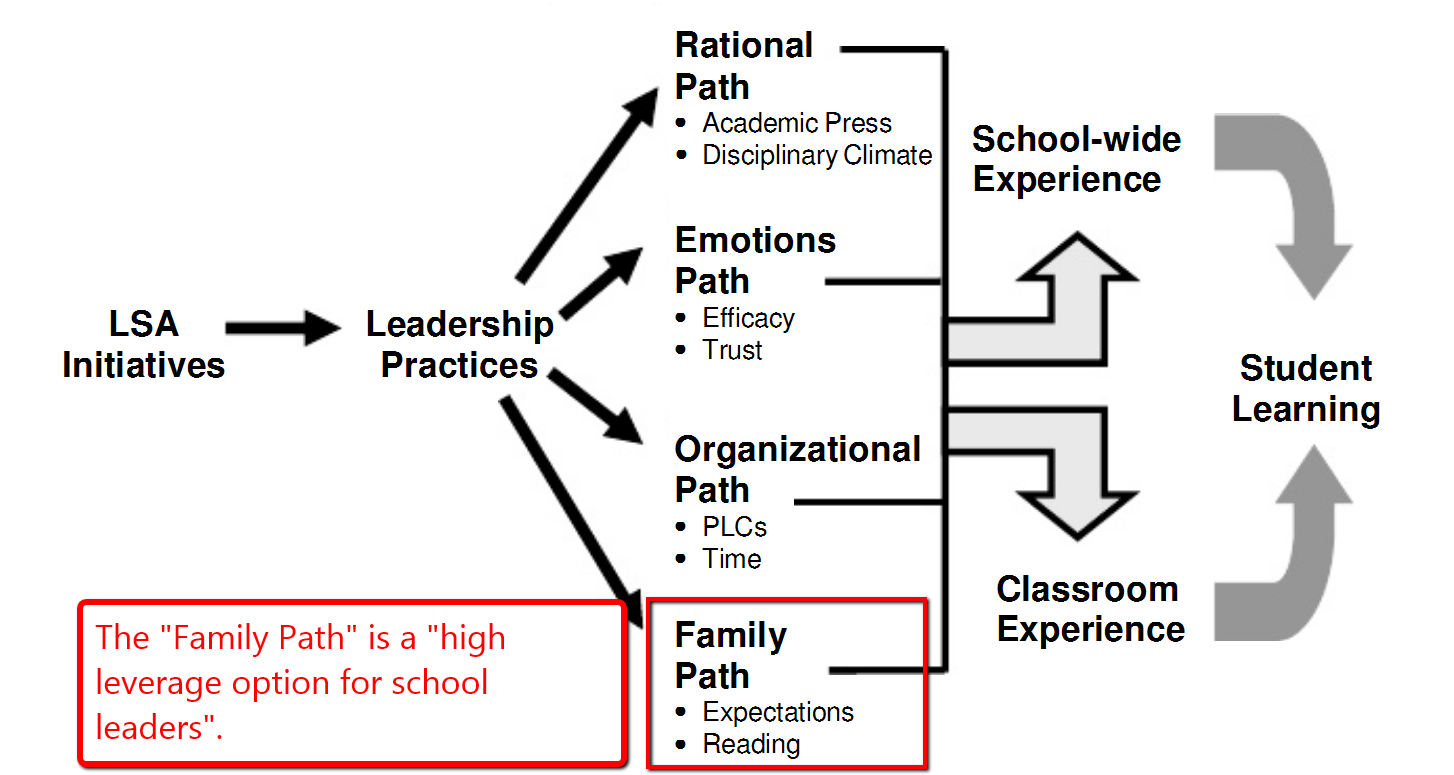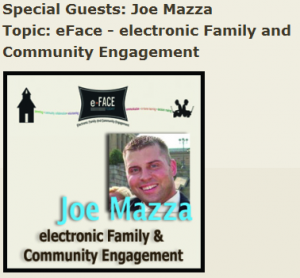I just participated in a great session with @Joe_Mazza through Classroom 2.0 Live (http://live.classroom20.com/) – a site that offers a free webinar series on topics related to education, teaching and learning. Today’s topic has motivated me to write a post I have been sitting on for some time and, as “they” say, there is no time like the present (whomever “they” are) 🙂
As Parent Engagement consultant for my school board (@HWDSB) I am passionate about making learning visible to parents, to make physical brick and mortar walls transparent, and to actively engage parents in the education and learning of their children. Now, when I say “engage” I don’t mean information conveyance through classical means such as newsletters (although they have their place), school signage or blanket invitations to school events, orientation nights, or fund raisers. When I say “engage” I mean actively interacting with parents, asking them what they need (rather than presuming the same) and giving them opportunities to roll their sleeves up and be part of the educational process.
Debbie Pushor outlines the difference between parent involvement and parent engagement in her work, “Parent Engagement: Creating a Shared World” (emphasis is mine)
Parent involvement is a common vehicle for bringing teachers and parents together in schools. Parent involvement programs “tend to be directed by the school and attempt to involve parents in school activities and/or teach parents specific skills and strategies for teaching and reinforcing school tasks at home” (Kellaghan, Sloane, Alvarez & Bloom, 1993, p. 85). Typically, parents are asked to serve in roles as “audience, spectators, fund raisers, aides and organizers” (McGilp & Michael, 1994, p. 2)
With parent involvement, the scripted story of school…does not change. Because the school is still setting the agenda and determining what roles parents are to play within that agenda, the hierarchical structure of educators as experts, acting in the best interests of the less-knowing parents, is maintained. With parent involvement, the focus is placed on what parents can do to help the school realize its intentioned outcomes for children, not on what the parents’ hopes, dreams or intentions for their children may be or on what the school can do to help parents realize their personal or family agendas
By this definition (parent involvement), then, parents are passive participants in the education and learning process of their children, they do not necessarily understand the language or processes of learning and are subject to knowing only what is provided to them by the teachers and schools as perceived experts. Who, though, is more of an expert in regards to the children in our classrooms than the parents themselves? Surely those parents have tons of information to offer in regards to the development and growth of the children they live with everyday. In fact, those parents are as much educators as those holding the role in classrooms. The subject matter may differ but the impact is profound.
Ken Leithwood, Professor in the Department of Theory and Policy Studies in Education at University of Toronto’s Ontario Institute for Studies in Education (OISE), discusses “The Family Path” and the absolute importance of engaging parents in the learning of their children at school and at home. Leithwood says,
Although parent involvement in school has far less impact on student learning than parent influence in the home, children benefit from their parents’ engagement in their learning in both locations (Epstein, 1995). Evidence from Leithwood and Jantzi’s (2006) review indicates that parent engagement in school is nurtured when parents come to understand that such involvement is a key part of what it means to be a responsible parent, when parents believe they have the skills and know-how to make meaningful contributions to the school’s efforts and when they believe that school staffs, as well as their own children, value their participation in the school. (Leithwood, School Leaders’ Influence on Learning; The Four Paths, p.8)
In How the Leading Student Achievement Project Improves Student Learning: An Evolving Theory of Action, Leithwood writes that, “…best estimates suggest that everything schools do within their walls accounts for about 20% of the variation in students’ achievement (e.g., Creemers &Reetzigt, 1996), influencing variables on the Family Path is a “high leverage” option for school leaders.”
George Couros, a Division Principal of Innovative Teaching and Learning with Parkland School Division, located in Stony Plain, Alberta, Canada, http://georgecouros.ca/blog/archives/tag/ken-leithwood shares a great list of onlime resources in regards to parent engagement http://www.diigo.com/list/gcouros/Parents and writes,
As we know that a parent’s engagement in their child’s learning significantly impacts the achievement and growth of each child, what are some other ways that we can facilitate this? Many parents are not able to spend significant time at school, so how can we do more to bring them in on their child’s learning? With easy access to technology, are there better ways that we can provide opportunities for parents to be more connected with this learning at home?
This is the lens through which I look at many things in education. I understand that technology does not engage all and is not the right enabler in all situations but in a growing and dynamic digital age I believe that we have a responsibility to harness the power that is available rather than letting that vital resource remain untapped merely because we don’t all understand how to use it.
Let’s return to Debbie Pushor’s differentation between the terms “parent involvement” and “parent engagement”. For her, parent engagement is “…is an alternative way to bring teachers and parents together in schools, an alternative possibility for changing the scripted story of school. “
Engagement,” in comparison to involvement, comes from en, meaning “make,” and gage, meaning “pledge” – to make a pledge (Harper, 2002), to make a moral commitment (Sykes, 1976, p. 343). The word engagement is further defined as “contact by fitting together; … the meshing of gears” (Engagement). The implication is that the person ‘engaged’ is an integral and essential part of a process, brought into the act because of care and commitment. By extension, engagement implies enabling parents to take their place alongside educators in the schooling of their children, fitting together their knowledge of children, teaching and learning, with teachers’ knowledge. With parent engagement, possibilities are created for the structure of schooling to be flattened, power and authority to be shared by educators and parents, and the agenda being served to be mutually determined and mutually beneficial. (Pushor & Ruitenberg, 2005, pp. 12-13) In this changed script, there is no longer a protectorate, no longer a protector and a protected. No longer are educators entering a community to claim the ground of school. No longer are educators working alone to design and enact policies, procedures, programs, schedules and routines for the sole benefit of the children of the community. Instead, educators are entering a community to create with parents a shared world on the ground of school – a world in which “parent knowledge” and teacher knowledge both inform decision-making, the determination of agendas, and the intended outcomes of their efforts for children, families, the community and the school. Both educators and parents wear badges which mark their knowing and their expertise. There is a sense of reciprocity in their mutual engagement, a sense of benefit for families and the school.
One way we could actively receive input with parents is through social media (a topic I will explore in part 2 of this post). Social media and digital tools, however, are not THE answer as we must remember that “…some families have far more resources than others to be involved in productive ways. Families facing poverty, linguistic and cultural diversity, unemployment and housing instability typically have considerable difficulty finding those resources.” (Leithwood, 2010, p.11) One could argue, however, that even those families that struggle financially have some access to technology either on their persons, in their homes, or in the community. Further, technology can help to bridge communication barriers between multi-lingustic and cultural groups.
Technology and digital tools will never replace face-to-face but I like how @Joe_Mazza referred to eFace in his presentation “electronic Family and Community Engagement”. It really is a blend of electronic and face-to-face. Here are links to Joe’s presentation – I’ll refer to them more in the next post.
https://twitter.com/#!/bloggucation/status/160778887511556096
Your thoughts?
eFace – “electronic Family and Community Engagement” by @Joe_Mazza – http://efacetoday.blogspot.com/
Recorded Classroom 2.0 Live Session: http://hnyctt.me/cr20live-JoeMazza
Resources from Classroom 2.l0 Live Session: http://live.classroom20.com/1/post/2012/01/eface-electronic-family-and-community-engagement.html
LiveBinders Resource: http://www.livebinders.com/play/play/266490
References
Couros, G. (2011). Untapped Resource? Engaging Parents in the Learning Process. Retrieved on January 21, 2012 from: http://georgecouros.ca/blog/archives/tag/ken-leithwood
Creemers, B. P. M., & Reezigt, G. J. (1996). School level conditions affecting theeffectiveness of instruction. School Effectiveness and School Improvement (7),197-228.
Harper, D. (2001). Engage. In Online etymology dictionary. Retrieved on October 3, 2005 from: http://www.etymonline.com/index.php?search=engage&searchmode=none
Hattie, J. (2009). Visible learning: A synthesis of over 800 meta-analyses relating to achievement. London, UK: Routledge.
Kellaghan, T., Sloane, K., Alvarez, B. & Bloom, B.S. (1993). The home environment and school learning. San Francisco, CA: Jossey-Bass Publishers.
Leithwood, K (2010). School Leaders’ Influences on Student Learning: The Four Paths. The Principles of Educational Leadership and Management. Retrieved on January 21, 2012 from: http://o.b5z.net/i/u/10063916/h/Pre-Conference/1__School_Leaders_Influence_4_paths_to_learning.pdf
Leithwood, K. (2010). How the Leading Student Achievement Project Improves Student Learning: An Evolving Theory of Action. Retrieved on January 21, 2012 from: http://www.scribd.com/doc/55363396/Leading-Student-Improvement-Project
McGilp, J. & Michael, M. (1994). The home-school connection: Guidelines for working with parents. Portsmouth, NH: Heinemann.
Pushor, D. (2007). Parent Engagement: Creating a Shared World. Retrieved on January 21, 2012 from: http://www.edu.gov.on.ca/eng/research/pushor.pdf
Pushor, D., Ruitenberg, C., with co-researchers from Princess Alexandra Community School. (2005, November). Parent engagement and leadership. Research report, project #134, Dr. Stirling McDowell Foundation for Research into Teaching, Saskatoon, SK, 79 pp.
Sykes, J.B. (Ed.). (1976). The concise Oxford English dictionary (6th ed.). London: Oxford University Press.








Thanks Aaron for joining us today on Classroom20 Live. Joe Mazza certainly is an inspiration and there were lots of good ideas shared in the chat. I am really impressed and amazed at the collection of resources and research on parent engagement and parent involvement that you have described in your blog post. It is so nice to see this conversation all in one place. I am looking forward to the second part of this post. HWDSB is very fortunate to have you in the role as Parent Engagement consultant. There are many parents wondering when their boards will have the same support. HWDSB is a real leader in all things technical as well as parent engagement. HURRAH !!
Aaron, I love this post of yours! I’m very passionate about parent engagement too, and I think that there’s tremendous value in making a real link between the parents and the school. Technology can be a great way to do this (and I’ve certainly used technology in this way in my own teaching situation), but it doesn’t need to be the only way. Equity is an incredibly important consideration here, and having opportunities to talk with parents, engage in discussions, and hear what they have to say is crucial. Ensuring that parents with English as their second language also have a voice in these discussions is very important. In the past, I know that we’ve had translators at different school events and meetings, which can help. I’ve even had siblings come along to school events, so that parents can feel comfortable speaking in their first language, and the siblings have acted as translators. It’s been great! I’m excited to read your next post and find out what other resources and ideas you have to share! Glad I get the chance to work in the same Board as you and learn from you both online and in person. I’m also glad that I saw your tweet today about Joe Mazza’s presentation, as Joe had tons of great ideas to share in his presentation, which you’ve definitely captured here.
Thanks Aaron for continuing to have me think tonight!
Aviva
Aaron- Thanks for participating today and also for thinking further on the challenges. I hope you can be a consistent contributor to #ptchat on Twitter and join us on Wednesday nights! We need to continue to share ideas and customize them to fit each of our varying needs each day. It was such a pleasure to read your posts and follow-up. Thanks also Lorna & Aviva- always feed off your passion and love your generous resource sharing!